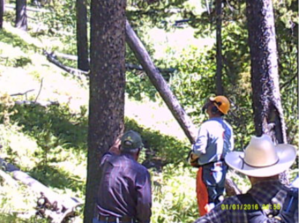 OHLEC is what we would call a new strategy being used when a sawyer approaches any given cutting situation. Using this strategy a sawyer can assess any potential situation in falling or bucking and limbing. The sawyer stating what they see and what their plan is, the rest of the trail crew now knows what to expect. If the sawyer starts getting in a bad situation the trail crew would know a deviation from the stated plan and voice there concerns. When mastered OHLEC takes only thirty seconds to announce. OHLEC also lets the trail crew become more involved in the cutting process.
OHLEC is what we would call a new strategy being used when a sawyer approaches any given cutting situation. Using this strategy a sawyer can assess any potential situation in falling or bucking and limbing. The sawyer stating what they see and what their plan is, the rest of the trail crew now knows what to expect. If the sawyer starts getting in a bad situation the trail crew would know a deviation from the stated plan and voice there concerns. When mastered OHLEC takes only thirty seconds to announce. OHLEC also lets the trail crew become more involved in the cutting process.
Objective
Regardless of task, develop a plan to determine where you want the cut piece to end up.
• If bucking, plan where you want the bucked log or round to go
• If limbing, determine sequence and direction for large branches when cut
• If brushing, particularly in thick brush, plan how you will remove the brush when it is cut
Hazards/obstacles
Develop a plan to identify the hazards/obstacles:
• That are overhead (fire, rotten top, widow makers and loose bark)
• That are in the piece of wood being cut (fire, rot and hinge wood integrity, hollow, bar/saw length compared to diameter, bees or poison plants)
• Springpoles
• Buildings, equipment or other trees you don’t want damaged
• That are associated with people and cutting area control
Leans/binds
Since lay, cut piece placement, sequence or removal was determined in O develop a plan to:
• Determine lean of a standing tree and calculate, in feet, the amount of head/back lean and side lean
• Determine binds in log to be bucked, spring poles, limbs or brush to be removed
Escape routes
Since leans and binds were determined in the previous step develop a plan to:
• Determine the ‘good’ and ‘bad’ side of the tree, log, springpole, limb or brush
• Determine and clear an escape route (or 2 routes if necessary for crosscut saw/axe work or situations that require two routes)
Cut Plan
Develop a cut plan to determine which technique will be used to remove wood fiber to achieve the desired result including:
• Face notch construction type (conventional, Humboldt or open face)
• Hinge position, length of hinge, depth of hinge and amount of stump shot needed
• Back cut type (straight in from the back or chase, boring back cut and out the back, boring back cut with release or holding wood or strap)
• Wedge placement including number of wedges and axe placement
• Sawyer communication to crew members, swamper or crosscut sawyer partner

